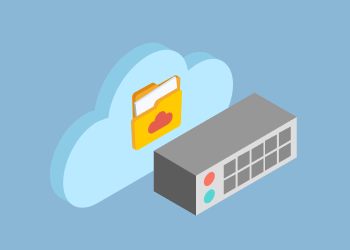Cloud data technologies have a lot of concepts which are usually misapprehended. Today, we will figure out what’s the difference between cloud storage, cloud backup, and cloud synchronization, and what suits best for common business tasks.
Table of Contents
What is Cloud Storage?
Basically, cloud storage is a virtual drive in a remote location, which is not attached to a certain physical computer or system. A common way of getting access to such storage is a special application or a web browser.
A storage service can provide access to files and folders like a local network share or a physically connected device. There are even applications that allow attaching a cloud storage account to a computer and getting access to it as a local drive.
In a cloud, you can store as much data as you need, since the provider’s storage boundaries are nearly unlimited, and most cloud service providers charge only for the space you use.
A cloud is quite a safe storage option, as data is usually replicated among several arrays so it is available even if any part of the data center is down. Leading cloud providers like AWS (Amazon Web Services) or Microsoft Azure even allow copying data across several regions worldwide. Consequently, it remains safe even in case of massive continent-wide disasters.
You can seamlessly integrate cloud storage with a business of any scale. It is a great option for use as a backup facility, a file server or a datastore for virtual machines in a cloud.
What is Cloud Backup?
If an application uses a set of some rules and policies to automatically send a copy of data to cloud storage, it is called cloud backup. The application and the datastore can represent independent parts or a single complete solution. Both approaches have advantages, but we suggest separating a backup application and storage in the cloud. With this approach, you get a more secure yet flexible solution and avoid vendor lock-in problems.
The ability to configure data transfer and storage according to your specific requirements differs cloud backup from cloud storage and cloud sync.
Good cloud backup should allow doing the following:
- Schedule regular data backup.
- Select individual files and folders to back up, or make a full system image with the ability to exclude certain files and folders.
- Encrypt data with a user password before uploading to the cloud.
- Set a number of file versions to keep the retention period.
- Track files for changes on the block level and upload only increments.
- Compress and deduplicate data to save on storage expenses.
Besides automation of routine backup tasks, a good cloud backup application comes with restore and disaster recovery options such as bare-metal recovery, item-level restore, restore to a cloud VM, etc. Advanced backup apps can also back up and recover Microsoft SQL Server and Oracle databases, Microsoft Exchange servers.
What is Cloud Sync?
Cloud sync keeps the same set of files and folders on client devices and cloud storage. One-way sync uploads files to the cloud as they’re modified and users can download them manually. With two-way sync, a cloud is an intermediate storage. When altered files are uploaded, all clients download them automatically. Almost all public services like Google Drive and Dropbox are based on two-way sync.
Sync services focus on business collaborations. Therefore, they have a lower data volume cap, a limited request rate, and don’t support advanced features like block-level management. Cloud sync systems rarely have pay-as-you-go pricing, so you have to pay for the entire storage capacity even if you use only one-third of it.
If you want to learn more, check Google Drive vs. Google Cloud Storage article.
Nevertheless, cloud sync is a great tool for proper tasks. Services like Google Drive and Microsoft OneDrive allow editing the same document by multiple users simultaneously, making it handy for collaboration. There are also native and third-party sync apps for mobile platforms.
You also can find a lot of cloud replication software tools for different business purposes available on the market. There are solutions for replication of CRM object schemas, such as DB Sync for Salesforce, for instance. The software automatically creates Salesforce object schemas, replicates objects in batch or real-time, and creates or updates Salesforce records from the database
For instance, some services allow sharing files with an unlimited number of people, which is a must for collaboration. Cloud sync allows users to edit data using any device, whether it is their local disk or smartphone internal storage. Then the changes they made are automatically transferred to the original file you shared, thus making its state the same across a number of locations.
Sync vs Backup vs Storage: The Difference Explained
The primary difference between sync vs backup vs storage is in the purpose. Cloud backup saves a copy of data on remote storage to protect it from undesired events, at the same time cloud storage is designed for getting access to data from anywhere. Cloud sync lets multiple users work with data remotely using any number of devices and synchronize changes across all the users involved. Meanwhile, such systems as Google Drive and Dropbox combine storage and sync features, offer data storage, unlimited access, and collaboration within a single service.
Conclusion
These were essentials of cloud storage, backup, and sync. Let’s summarize key points:
- Cloud storage is an offsite datastore, which keeps data in a remote data center and provides access via the Internet. Although it’s a part of backup and sync, it’s a concept of a different order.
- Cloud backup is a solution that automates and facilitates data transfer to cloud storage according to a set of custom configurations.
- Cloud synchronization helps to share files with other users and synchronize data across multiple devices.
Feel free to share your impressions in the comments section below!





